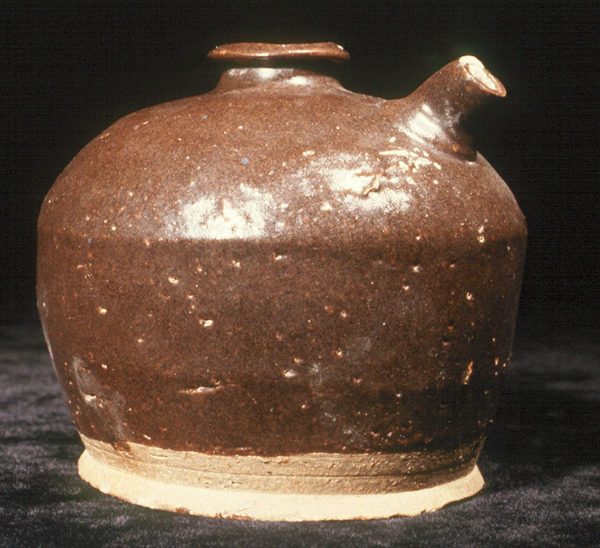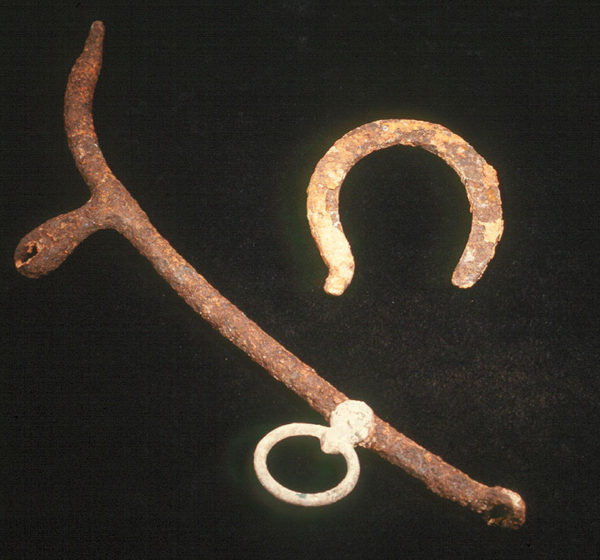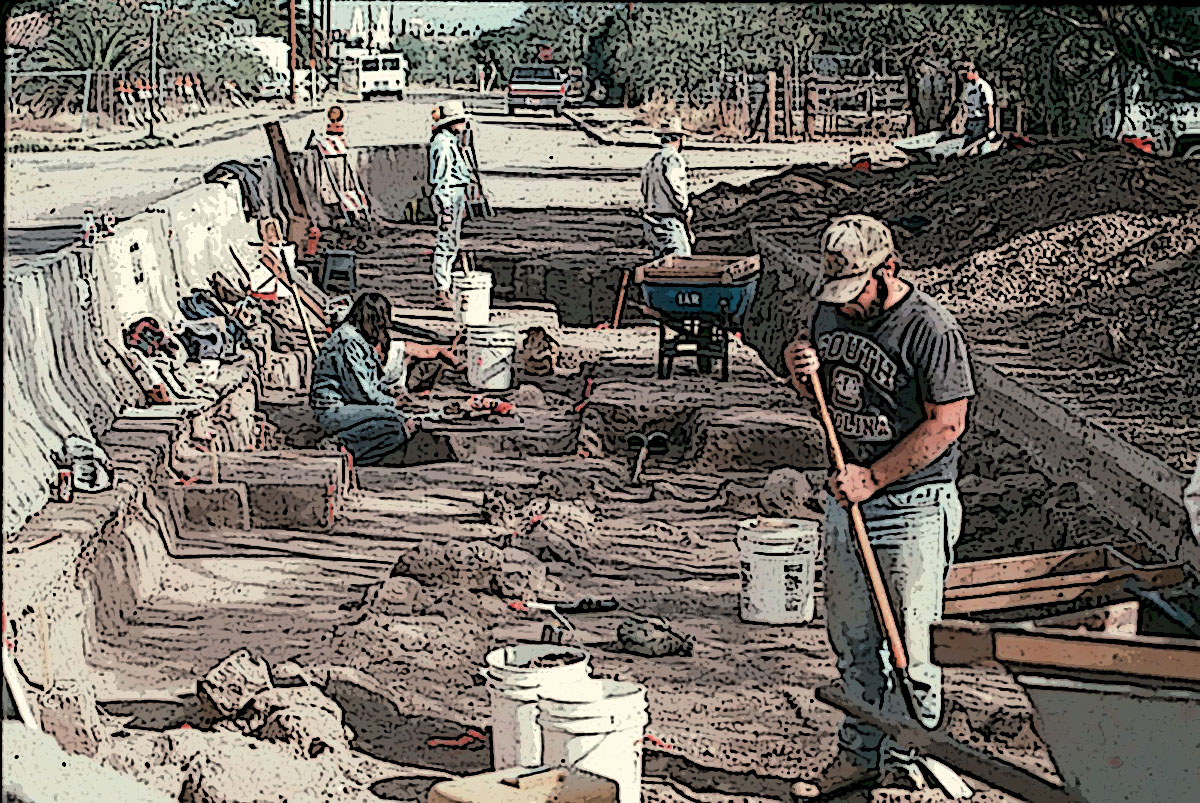
Archaeology Archive: What Lay Beneath Spruce Street
Homer Thiel discusses what we learned about the Chinese men who came to Tucson while working on the railroad in the late 1800s and stayed here to make lives for themselves.
In the late 1980s and early 1990s, a housing development was constructed along the road leading to the summit of Sentinel Peak (“A” Mountain). An unanticipated consequence of the new houses was that the newly compacted land they were built on could no longer absorb monsoon rains, and the neighborhood below began to suffer from flooding. To remediate this, the City of Tucson decided to construct a storm drain. Before this could take place, the city contracted Desert Archaeology to do a testing project to determine whether archaeological resources were present in the route of the drain.
In 1994, weexcavated a backhoe trench along West Spruce Street and across the Rio Nuevo South property east of South Grande Avenue. Our crew identified three sets of features beneath West Spruce Street, with a large canal near the west end of the excavated area. This was the Acequia Madre Tercia, the Third Mother Canal, depicted on a map of Tucson agricultural fields commissioned in 1862 and rendered by US Army Major David Fergusson. This map shows a series of canals snaking through the Santa Cruz River floodplain. Three of the labeled large canals directed water from the river and from springs at the base of Sentinel Peak into smaller canals that formed the boundaries of fields.
The Acequia Madre Segunda, the Second Mother Canal, runs north along the east side of South Palomas Avenue and is visible in the wall of a currently standing house, where some of the bricks have settled into the canal.
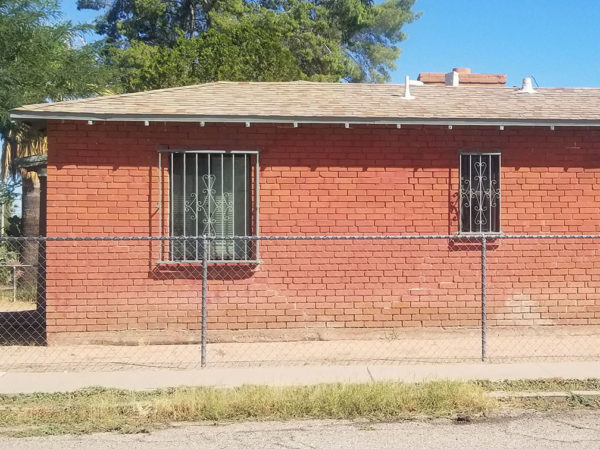
A U-shaped crack between the two windows in a south wall of a house on South Palomas Avenue reveals the profile of the Acequia Madre Segunda (photo by Homer Thiel).
Farther down Spruce away from the canal, we encountered several Early Agricultural period pithouses along the north side of the street. Because these were in an area that would not be affected by the drain, we did not excavate them but instead left them preserved in place.
To the east of the canal, the backhoe trench cut through a rock foundation and a large trash-filled pit. We pulled many artifacts from the backdirt pile next to the pit, including fragments of Chinese porcelain and earthenware vessels. These indicated that Chinese people had lived at the site, and this is where we returned for an archaeological excavation.
Documentary research before fieldwork began indicated the site likely was occupied by Chinese gardeners. Neighbors remembered the men working in the fields in the 1930s. The men had arrived with the construction crews of the Southern Pacific Railroad. Many men stayed behind and opened restaurants, stores, and laundries. About 30 of the men decided to grow produce, as local Mexican farmers were not growing the types of crops that newly-arrived European-Americans wanted, such as potatoes, cabbages, carrots, artichokes, cantaloupes, and strawberries. They also raised carp and pigs. Life in America was difficult for Chinese immigrants, especially after the 1892 Chinese Exclusion Act (the Geary Act), which sharply limited Chinese immigration and forced the immigrants in Tucson to carry identification papers at all times or risk being deported.
At the start of the fieldwork, the asphalt south lane of West Spruce Street was removed and the area was stripped, revealing 18 features. One was the rock foundation of an adobe structure that extended into the lot to the south of the street. It apparently was a compound, with rooms extending out from the main walls. A wooden barrel (Feature 2005) set into the ground may have held water pulled from the nearby canal. A small, shallow outhouse or privy (Feature 2002) was outside the building. The Chinese often were employed to empty outhouses and used the waste on their agricultural fields. Residents mined soil from the large pit to the east of the house (Feature 124/2004) for adobe brick manufacturing, and afterward used the pit for trash disposal. We recovered a large quantity of artifacts and food remains here. A few of the features dated to an earlier occupation by a Mexican family, who likely built the structure.

Plan map of the Chinese gardener’s household, showing location of archaeological features (Desert Archaeology Technical Report 96-22).
The excavation recovered 10,842 artifacts. representing seven broad categories.
About 52 percent of these items were used in the kitchen. They included a colander, a kettle, and pieces of 44 different Tohono O’odham cooking and water storage jars. More common were fragments from 125 food serving vessels, many of which were manufactured in China. It became apparent that it was very important for the Chinese gardeners to maintain their food customs, including using imported rice bowls and sauce bowls, along with ceramic spoons.
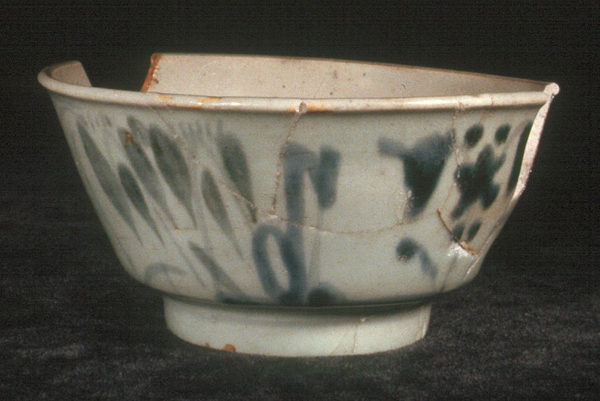
A Bamboo pattern rice bowl and a Four Flowers pattern sauce dish were manufactured in China (photo by Gregory Berg).
Chinese soy sauce jugs and earthenware jars that once held salted and pickled foods were common. The gardeners were attempting to replicate their traditional diet by using familiar flavors imported from their faraway homeland.
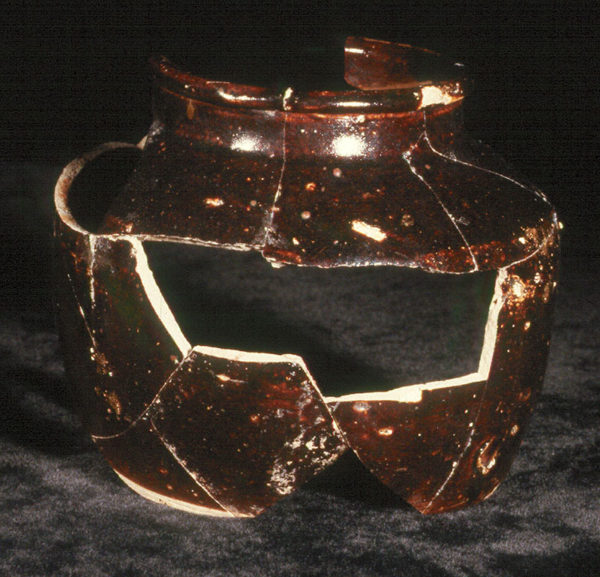
A wide-mouth jar that could have held preserved tofu, sweet bean paste, beans, pickled turnips, cabbage, shrimp paste, sugar, or other condiments (photo by Gregory Berg).
Dr. Michael Diehl examined 15 flotation samples of plant remains collected from the Chinese features and identified many types of greens, as well as peppers, cactus fruit, purslane, and wheat. Jenny Waters analyzed animal bones and found a wide variety of species, including fish, turtle, duck, deer, cattle, and pig. Historical accounts indicate that the Chinese in the United States were known for eating a much more diverse and healthier diet than other groups.
We recovered numerous architectural artifacts from building construction, including almost 1,800 nails. While some of the nails were probably used in the building at the site, others may have been present in scavenged firewood, used in cooking fires. Pieces of window glass and a doorknob suggest the building had both.
Furniture artifacts are rare at most historical archaeological sites because these items are long-lasting and were taken along when people moved away. Hardware from a chest of drawers, a clock, and a mirror were found. Also recovered were pieces from three lamp chimneys and a brass burner from a kerosene lamp, revealing how the Chinese gardeners lit their homes at night.
A total of 184 pieces of ammunition were found. These suggested that the Chinese gardeners owned several types of firearms including pistols and shotguns. Contemporary newspaper articles reveal frequent altercations took place between the Chinese and Mexican-Americans. Both groups were struggling to make a living in the discriminatory world of late 19th century Tucson. The Chinese angered the Mexican-Americans because they would work for less money and because they operated many of the grocery stores in the community. The money earned from these and other businesses was often sent overseas to family members back in China. Some of the Chinese men carried firearms with them for personal protection.
Clothing preserves poorly in the ground. We found buttons, eyelets, shoe parts, suspender buckles, two belt buckles, along with a few pieces of cloth. Most of these items were typical of Western clothing but 38 Chinese brass jacket buttons were present. Chinese immigrants quickly adopted Western clothing in an effort to blend in, while probably wearing traditional clothing at home or in their fields.
Personal items are those likely to have been used by an individual or a small group of people. We found a pocketknife, a Chinese padlock, and a skeleton key. Seven coins were found including an 1891 dime and an 1884 half-dime. The three Chinese coins we recovered were likely used among members of the Chinese community for purchases and during gambling games.
Several Chinese medicine bottles were present. These contained a type of medicine that was inhaled, the person holding the bottle under their nose.
Recreation artifacts included Chinese rice wine bottles and glass beer bottles probably filled at bottling works in Tucson. Also found was an opium pipe fragment and pieces from four brass opium tins. Opium use was legal in Arizona until the 1910s. A fan-tan or go gaming piece, from a popular Chinese game, was also found, as well as a domino.
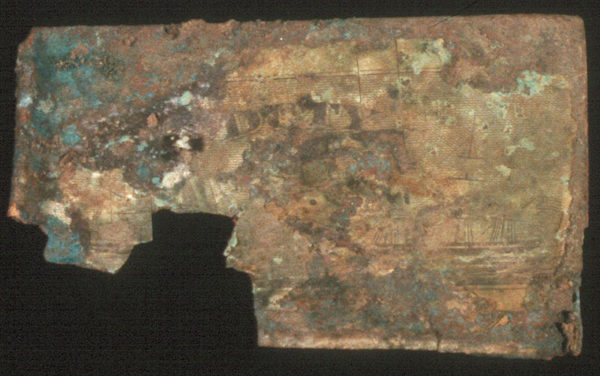
A brass opium tin. A paper label with two clipper ships facing each other, beneath the word DUTY (which indicates tax had been paid) is barely visible (photo by Gregory Berg).
Activity artifacts include those used during work. Eleven agricultural tools were found. These were a large mattock, a hoe, and pieces of a horse-drawn plow. Numerous pieces of tin buckets were found. These were used to cover plants as they started to grow to shade them from the midday sun and to carry water from canals to the fields.
Transportation artifacts included horse harness parts, a saddle fragment, and a pair of horse hoof clippers. The gardeners used horses to plow their fields and to pull the wagons on which they had loaded produce or meat to take to restaurants, stores, or to their route customers.
At the beginning of our investigations under Spruce Street, we had a few newspaper articles and oral histories in hand that described the lives of the Chinese gardeners. Our excavations allowed us to supplement these with the information gleaned from the recovered artifacts, food remains, and features. The Chinese men were successful at raising a variety of foods for the tables of their neighbors. While assimilating into the local culture in some aspects of their lives, they retained much of their traditional customs, especially in regards to their diet. As restrictive laws were passed, fewer Chinese men worked as gardeners, and fresh fruits and vegetables had to be imported from elsewhere into Tucson. Recently, a Chinese garden was planted at Mission Garden, allowing visitors to see some of the crops grown by the historic Chinese gardeners.
Resources
Lee Wee Kwon: Chinese Grocer in Tucson, 1917-1965
A PDF of the report on the fieldwork can be purchased from Archaeology Southwest.



